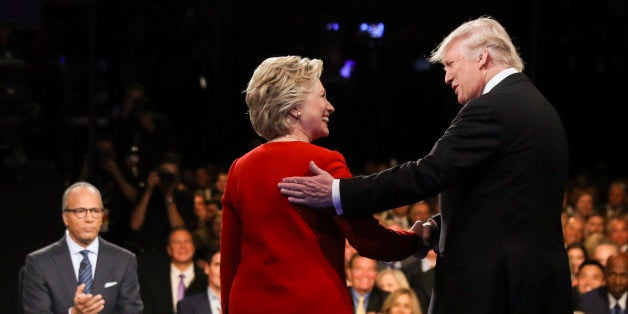
Tonight, Washington University in St. Louis (Wash. U. to those of us who work and study here) will host the second debate of the 2016 Presidential election.
In the run-up to the debate, everyone is asking the same question: will this debate generate the same sparks that Donald Trump and Hillary Clinton produced at the first debate at Hofstra on September 26? And of course everybody is wondering how both candidates will discuss Trump's comments about women in the recently released recording from 2005. The other, less obvious question is whether the town-hall format of the second debate will make for a different outcome than the podium-style first debate. The 2005 Trump recording may be dominating the news cycle, but the debate format will determine how the candidates will address this latest controversy, as well as every other subject at the debate.
What's Different About the Second Debate?
This will be the second town-hall debate hosted by Wash. U. (the other was the Bush-Kerry town hall debate in 2004), and fifth debate overall hosted by our school. When the Commission on Presidential Debates rolled out the town hall in 1992, this new format was supposed to improve the debate process in several ways. It also rested on certain assumptions about Presidents, the election process, and the American people.
The town-hall format was -- and still is -- supposed to democratize the Presidential-debate system. Average citizens -- undecided voters selected beforehand --pose questions directly to the candidates. In the process, the debate implicitly assumes that average citizens have different interests and different concerns from the journalists who had always posed the questions to candidates in previous debates and continue to do so in podium-style debates. Journalists serve as moderators of the town-hall debate (in this case, Anderson Cooper and Martha Raddatz). But town-hall moderators tend to operate more as traffic cops than interrogators, introducing the people asking the questions and encouraging candidates to answer those questions.
The town-hall format is supposed to reveal the candidates in a way that is more honest, more direct, and somehow more intimate. Sitting casually (but never comfortably) on glorified bar stools, walking around the stage and each other, taking questions from average Americans with a respectful give-and-take, the candidates have tried to dispense with much of the formality of the podium-style debate.
What That Difference Could Mean
The town-hall format requires very different skills from the podium-style debate and can produce very different results. That was the case from its very beginning. At the first town hall in 1992, Bill Clinton talked circles around George H.W. Bush and Ross Perot, in sharp contrast to the podium-style debates where Clinton and Bush were more evenly matched. Over time, however, the town hall has become much the same as the other debate formats. This change was fully in place by 2008, when Barack Obama and John McCain listened politely, thanked the undecided voters for their commitment to the process, and then proceeded to ignore their questions by pivoting to a set of prepared talking points.
If ever there were two candidates who didn't appear to be cut out for the town hall, those candidates are Donald Trump and Hillary Clinton. Trump performs best in large crowds rather than intimate conversations. Meanwhile, the unpredictable quality of town-hall questions only increases the likelihood that Trump will go wherever his mind takes him. That move clearly hurt him in the first debate. But Hillary Clinton should be worried, as well. The most effective town-hall debaters are those who can immediately establish a connection with the person asking a question. Clinton has struggled to build those bonds.
One thing we've learned time and again in this election is that it's impossible to make accurate predictions about the behaviors of these two candidates. But one thing is clear: the degree of difficulty for these specific candidates is certainly higher in the town-hall debate, since the structure does not play to their strengths. And there's more at stake than this one election. The town-hall style has yet to deliver on its promise.
So be prepared for two candidates who must force themselves to appear at ease in their least comfortable political setting.
In addition, be prepared for a test of the town-hall format. Throughout this election, critics have charged that both candidates have failed to make themselves accessible to close scrutiny from journalists. The question is whether average Americans can achieve what journalists have not.
This post is part of an editorial series produced by The Huffington Post in conjunction with the four presidential debates held this fall by the Commission on Presidential Debates. Each of the four debates will be held at a college or university, and the author of each post in this series will be a professor at the participating school (Hofstra University; Longwood University; Washington University in St. Louis; and University of Nevada, Las Vegas). To see all the posts in the series, visit here.